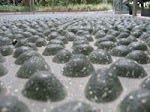If you do frequently wear high heels or shoes that are too narrow or too short for your feet, you and your feet might be suffering from a number of ailments such as corns, calluses, toenail problems, bunions to name but a few. Not to scare you (well actually yes if it helps), a worst case scenario of long term abuse of your feet through ill fitting shoes could leave your feet looking something like this:

Compared to the sought after sexy factor of the high heels, these feet are anything but sexy! This is a bad case of bunions.
Problems like this do not just happen overnight, they build up over time. Research undertaken by D. Casey Kerrigan, M.D., M.S. of the University of Virginia has also linked the wearing of high heels to knee osteoarthritis, a painful, degenerative joint disease.
The images in this chart show us some of the major issues (Click on the image to enlarge):

It's not only your shoes affecting your feet, age does as well. As you get older your feet become wider and longer and the natural padding under your heel and forefeet thins. Your feet and ankles become stiffer (ask any reflexologist) through years of standing and walking and your arches flatten.
So back to that question, can I keep my high heels or are their days numbered?
Well not entirely, according to Martin Ellman, D.P.M., a specialist in podiatry at the Mayo Clinic, Rochester, Minn.
"You can still wear high heels, but save them for special occasions," says Dr.Ellman. "...Avoid wearing high heels every day to minimize your risk of developing foot problems." The advice from Dr. Ellman is to "wear comfortable shoes eg trainers whenever you can for your commute to work and then changing into high heels once you arrive. Limit heel height to an inch and a half, and don't wear your high heels all day. For instance, if you have an important event in the morning, wear the high heels then, and switch to lower heeled shoes in the afternoon. Alternate your shoe choice throughout the day or from one day to the next."
So here are some tips to think about when buying your next pair of shoes:
- Get your feet measured -your foot size can change with age
- Choose sensible heels -try to select shoes with low heels eg. an inch and a half or less
- Try the shoe on even if it's in your size-every shoe is different and you're going to be wearing them-get it right from the start!
- Compare the shoe width with the width of your foot - try to avoid shoes that are to narrow for your feet
- Try both shoes on - If you're like me and both of your feet are a different size then you need to know the difference and if both shoes feel comfortable for you
- Shop for shoes late in the afternoon or in the evening - Your feet swell during the course of the day so try to hold out and resist the urge if it's at all possible!
"Baby I’ve got plans tonight
You don’t know nothin’ about
I’ve been sitting around way too long
Trying to figure you out
But you say that you’ll call and you don’t
And I’m spinning my wheels
So I’m going out tonight
In my red high heels"
*Sources used in the production of this article include The Mayo Foundation for Medical Education and Research and Science Direct, many thanks


.jpg)


